
|
It approaches to Sun down to 0.09 a.u. on Jan. 13. Now it is 4.9 mag (Dec. 31, Marco Goiato). According to the calculation, it will brighten up to -3 mag. But probably, it will be disintegrated. In the Northern Hemisphere, it will never be observable after this. In the Southern Hemisphere, it will be unobservable soon. But it may be observable after mid January.
Date(TT) R.A. (2000) Decl. Delta r Elong. m1 Best Time(A, h)
Dec. 28 17 15.87 -32 52.6 1.481 0.631 18 5.9 3:40 (306, 6)
Jan. 4 17 50.84 -27 55.5 1.260 0.418 16 3.7 3:46 (303, 3)
|

|
It brightened up to -3 mag due to the forward scattering on Oct. 9 in the SOHO coronagraph images (Q.-c. Zhang, Charles S. Morris). It became a great comet of 0 mag on the ground. Now it is 10.1 mag (Dec. 26, Osamu Miyazaki). Fading gradually. In the Northern Hemisphere, it will be unobservable in January. But it will be observable again in January. In the Southern Hemisphere, it is not observable now, but it will appear in March.
Date(TT) R.A. (2000) Decl. Delta r Elong. m1 Best Time(A, h)
Dec. 28 19 37.87 6 1.0 2.651 1.915 33 10.2 21:03 ( 78,-27)
Jan. 4 19 44.34 6 35.0 2.797 2.024 31 10.5 21:03 ( 75,-31)
|

|
It approached to Earth down to 0.55 a.u. in early December, and it brightened up to 10.7 mag (Dec. 5, Mike Olason). Now it is 12.4 mag (Dec. 22, Osamu Miyazaki). It will fade out rapidly after this. It will be fainter than 18 mag in March. In the Northern Hemisphere, it will be getting lower gradually. In the Southern Hemisphere, it will never be observable after this.
Date(TT) R.A. (2000) Decl. Delta r Elong. m1 Best Time(A, h)
Dec. 28 21 10.02 47 51.7 0.851 1.182 79 12.2 21:03 (130,-28)
Jan. 4 21 39.73 40 49.8 1.044 1.218 73 12.9 21:03 (123,-25)
|

|
It returned for the first time in 68 years. It brightened up to 6.2 mag in early summer (July 1, Virgilio Gonano). Now it is 10.1 mag (Nov. 10, Mike Olason). Fading gradually. In the Northern Hemisphere, it will be unobservable in January. But it will be observable again in January. In the Southern Hemisphere, it is not observable now, but it will appear in January.
Date(TT) R.A. (2000) Decl. Delta r Elong. m1 Best Time(A, h)
Dec. 28 17 21.33 -15 8.9 3.641 2.720 17 12.4 3:00 (300,-13)
Jan. 4 17 31.21 -15 52.8 3.682 2.793 21 12.6 3:06 (296, -8)
|
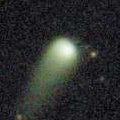
|
Now it is 12.9 mag (Dec. 24, Osamu Miyazaki). Fading slowly. In the Northern Hemisphere, it stays observable in good condition. In the Southern Hemisphere, it is not observable now.
Date(TT) R.A. (2000) Decl. Delta r Elong. m1 Best Time(A, h)
Dec. 28 2 29.11 64 21.9 3.148 3.785 123 12.8 21:03 (173,-10)
Jan. 4 2 8.20 62 17.3 3.238 3.801 118 12.9 21:03 (167,-10)
|
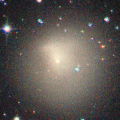
|
Major outburst occured between Nov. 1 and 2. Another outburst occured in late November. Now it is 12.6 mag (Dec. 23, Osamu Miyazaki). It stays observable in good condition.
Date(TT) R.A. (2000) Decl. Delta r Elong. m1 Best Time(A, h)
Dec. 28 10 12.19 8 47.7 5.622 6.233 124 13.7 3:00 (196, 45)
Jan. 4 10 10.88 8 47.8 5.534 6.234 131 13.7 3:06 (184, 46)
|

|
It returns for the first time in 70 years. It brightened up to 3.7 mag in early April (Apr. 6, Jose Guilherme Aguiar). Now it is 14.6 mag (Oct. 22, Hidetaka Sato). Fading slowly. In the Northern Hemisphere, it is not observable now, but it will appear in February. In the Southern Hemisphere, it will be getting higher gradually.
Date(TT) R.A. (2000) Decl. Delta r Elong. m1 Best Time(A, h)
Dec. 28 16 26.77 -48 10.8 4.394 3.627 34 13.8 3:00 (318, 17)
Jan. 4 16 35.42 -48 19.6 4.423 3.700 38 13.9 3:06 (316, 20)
|

|
It brightened up to 12.7 mag in summer (Aug. 7, Thomas Lehmann). Now it is 14.2 mag (Dec. 10, Ken-ichi Kadota). Fading slowly. In the Northern Hemisphere, it will be unobservable in January. But it will be observable again in March. In the Southern Hemisphere, it is not observable now, but it will appear in March.
Date(TT) R.A. (2000) Decl. Delta r Elong. m1 Best Time(A, h)
Dec. 28 20 3.13 -13 9.2 3.270 2.413 24 13.8 21:03 ( 67,-10)
Jan. 4 20 14.92 -11 10.3 3.316 2.429 21 13.9 21:03 ( 66,-14)
|

|
Brightening rapidly. Now it is not observable. It will brighten up to 10 mag in 2025 spring. But the condition of this apparition is bad. It is not observable when the comet is bright.
Date(TT) R.A. (2000) Decl. Delta r Elong. m1 Best Time(A, h)
Dec. 28 18 48.47 -3 6.7 2.432 1.552 20 14.3 21:03 ( 61,-30)
Jan. 4 19 9.72 -3 0.4 2.374 1.488 19 13.9 21:03 ( 60,-31)
|

|
Now it is 14.1 mag (Dec. 23, ATLAS Chile). It stays 14 mag for a while. It stays observable in good condition.
Date(TT) R.A. (2000) Decl. Delta r Elong. m1 Best Time(A, h)
Dec. 28 6 32.39 4 43.9 4.851 5.792 161 14.1 0:07 (180, 50)
Jan. 4 6 29.41 5 13.8 4.836 5.776 161 14.1 23:32 (180, 50)
|

|
Now it is 13.4 mag (Dec. 19, Ken-ichi Kadota). It will fade out rapidly after this. It will be unobservable in January in the Southern Hemisphere, or in February in the Northern Hemisphere.
Date(TT) R.A. (2000) Decl. Delta r Elong. m1 Best Time(A, h)
Dec. 28 20 47.61 -16 23.6 2.521 1.785 33 14.2 21:03 ( 71, 1)
Jan. 4 21 6.15 -14 44.8 2.583 1.814 31 14.3 21:03 ( 71, -2)
|

|
Now it is 14.3 mag (Dec. 22, Ken-ichi Kadota). It stays 14 mag for a while. It will be getting higher gradually.
Date(TT) R.A. (2000) Decl. Delta r Elong. m1 Best Time(A, h)
Dec. 28 14 57.61 -19 2.3 5.645 5.054 48 14.3 3:00 (282, 17)
Jan. 4 15 3.37 -18 52.0 5.565 5.063 54 14.3 3:06 (278, 22)
|

|
It is expected to brighten up to 13 mag in 2025 autumn, and it will be observable in good condition. Now it is 14.8 mag (Dec. 21, Purple Mountain Observatory, XuYi Station). It stays 15 mag for a while. It will be unobservable in February in the Southern Hemisphere, or in March in the Northern Hemisphere.
Date(TT) R.A. (2000) Decl. Delta r Elong. m1 Best Time(A, h)
Dec. 28 23 0.53 -2 53.1 4.519 4.264 68 14.6 21:03 (101, 20)
Jan. 4 23 6.13 -2 17.6 4.588 4.238 63 14.6 21:03 ( 98, 15)
|

|
Brightened rapidly. Now it is 14.8 mag (Dec. 12, Ken-ichi Kadota). It stays 14 mag for a while. In the Northern Hemisphere, it will be unobservable in April. In the Southern Hemisphere, it is not observable now.
Date(TT) R.A. (2000) Decl. Delta r Elong. m1 Best Time(A, h)
Dec. 28 19 2.32 32 51.1 2.452 2.081 56 14.7 21:03 (103,-46)
Jan. 4 19 27.67 32 2.9 2.434 2.040 55 14.6 21:03 (102,-47)
|

|
Now it is 15.2 mag (Dec. 14, Ken-ichi Kadota). It stays 15 mag for a while. It stays observable in good condition.
Date(TT) R.A. (2000) Decl. Delta r Elong. m1 Best Time(A, h)
Dec. 28 9 18.65 19 19.5 1.811 2.643 140 14.7 2:53 (180, 36)
Jan. 4 9 16.10 19 10.9 1.753 2.638 147 14.6 2:23 (180, 36)
|

|
It has not been observed yet in this apparition. It brightens up to 11.5 mag, but it will turn to fade out rapidly after that. It will be fainter than 18 mag in March. It will be unobservable in January. It will approach to Sun down to 0.5 a.u. in February and brighten up to 11.5 mag. However, it is not observable at the high light.
Date(TT) R.A. (2000) Decl. Delta r Elong. m1 Best Time(A, h)
Dec. 28 16 26.55 -23 25.3 1.621 0.880 27 15.7 3:00 (297, 2)
Jan. 4 17 10.86 -23 51.5 1.552 0.778 24 14.7 3:06 (299, 1)
|

|
Almost stellar. Now it is 14.4 mag (Dec. 26, Juan Jose Gonzalez). It will fade out rapidly after this. It will be fainter than 18 mag in March. In the Northern Hemisphere, it stays observable in good condition. In the Southern Hemisphere, it will be unobservable in January.
Date(TT) R.A. (2000) Decl. Delta r Elong. m1 Best Time(A, h)
Dec. 28 3 27.42 35 22.9 0.905 1.771 139 15.1 21:03 (179, 19)
Jan. 4 3 4.12 39 38.1 1.016 1.797 128 15.5 21:03 (169, 14)
|

|
It brightened up to 13.1 mag in autumn (Nov. 1, Thomas Lehmann). Now it is 14.0 mag (Dec. 1, Thomas Lehmann). Fading gradually. It will be fainter than 18 mag in April. In the Northern Hemisphere, it will be getting higher gradually. In the Southern Hemisphere, it is not observable now, but it will appear in February.
Date(TT) R.A. (2000) Decl. Delta r Elong. m1 Best Time(A, h)
Dec. 28 16 57.27 21 24.0 2.441 1.956 49 15.1 3:00 (264,-30)
Jan. 4 17 8.95 20 0.4 2.484 2.007 50 15.3 3:06 (262,-25)
|

|
Bright new comet. Now it is 14.5 mag (Dec. 27, Martin Masek). It will fade out rapidly after this. It will be fainter than 18 mag in February. In the Northern Hemisphere, it is not observable now, but it will appear in January. In the Southern Hemisphere, it stays observable in good condition.
Date(TT) R.A. (2000) Decl. Delta r Elong. m1 Best Time(A, h)
Dec. 28 22 35.36 -68 47.5 1.074 1.006 58 15.2 21:03 ( 26, 39)
Jan. 4 0 14.34 -65 41.3 1.034 1.082 64 15.4 21:03 ( 30, 46)
|
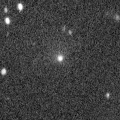
|
Very large comet. It is expected to brighten up to 13 mag in 2031. Now it is 15.8 mag (Dec. 16, ATLAS Chile). It stays 15 mag for a while. In the Northern Hemisphere, it is not observable now. In the Southern Hemisphere, it stays observable in good condition. In the Northern Hemisphere, it is not observable until 2030.
Date(TT) R.A. (2000) Decl. Delta r Elong. m1 Best Time(A, h)
Dec. 28 3 40.32 -70 31.0 15.718 15.606 81 15.4 21:10 ( 0, 55)
Jan. 4 3 37.63 -70 18.4 15.715 15.583 80 15.4 21:03 ( 3, 55)
|
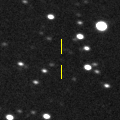
|
Now it is 16.6 mag (Oct. 9, Hidetaka Sato). Brightening slowly. Now it is not observable. It will appear in March in the Southern Hemisphere.
Date(TT) R.A. (2000) Decl. Delta r Elong. m1 Best Time(A, h)
Dec. 28 19 39.19 -23 2.2 2.995 2.070 16 15.6 21:03 ( 55, -7)
Jan. 4 19 56.83 -22 40.4 3.001 2.057 13 15.5 21:03 ( 54, -9)
|

|
Now it is 15.2 mag (Dec. 6, Masayoshi Yoshimi). Fading slowly. It stays observable in good condition.
Date(TT) R.A. (2000) Decl. Delta r Elong. m1 Best Time(A, h)
Dec. 28 6 23.71 9 18.1 2.619 3.581 165 15.6 23:54 (180, 46)
Jan. 4 6 19.77 9 18.0 2.643 3.597 163 15.6 23:23 (180, 46)
|
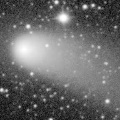
|
It brightened up to 9.6 mag from February to March in 2024 (Feb. 25, 2024, Thomas Lehmann). Now it is 15.6 mag (Dec. 13, Thomas Lehmann). Fading slowly. In the Northern Hemisphere, it will be getting lower gradually. But it will be getting higher again after March. In the Southern Hemisphere, it is not observable now.
Date(TT) R.A. (2000) Decl. Delta r Elong. m1 Best Time(A, h)
Dec. 28 21 14.95 31 33.4 4.463 4.192 67 15.6 21:03 (115,-21)
Jan. 4 21 23.71 31 14.9 4.596 4.261 64 15.7 21:03 (113,-24)
|

|
Now it is 15.6 mag (Dec. 16, Ken-ichi Kadota). It stays 16 mag for a while. In the Northern Hemisphere, it stays observable in good condition. It locates somewhat low in the Southern Hemisphere.
Date(TT) R.A. (2000) Decl. Delta r Elong. m1 Best Time(A, h)
Dec. 28 1 43.97 14 14.9 2.360 2.888 112 15.7 21:03 (148, 34)
Jan. 4 1 46.85 14 5.0 2.428 2.863 106 15.6 21:03 (142, 32)
|
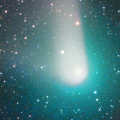
|
It brightened up to 8 mag from 2022 summer to 2023 spring. Now it is 15.5 mag (Dec. 3, ATLAS-MLO, Mauna Loa). Fading slowly. It stays observable in good condition.
Date(TT) R.A. (2000) Decl. Delta r Elong. m1 Best Time(A, h)
Dec. 28 5 46.82 21 6.9 6.634 7.605 170 15.7 23:17 (180, 34)
Jan. 4 5 42.52 21 21.4 6.716 7.659 162 15.8 22:45 (180, 34)
|

|
Now it is 16.1 mag (Dec. 18, ATLAS South Africa). It stays 16 mag for a while. It stays observable in good condition.
Date(TT) R.A. (2000) Decl. Delta r Elong. m1 Best Time(A, h)
Dec. 28 7 39.92 -24 8.8 3.446 4.141 129 15.8 1:14 (180, 79)
Jan. 4 7 31.75 -22 56.6 3.380 4.120 133 15.8 0:39 (180, 78)
|

|
First return of a new periodic comet which brightened up to 16 mag in 2012. Now it is 15.0 mag (Dec. 10, Ken-ichi Kadota). It will fade out rapidly after this. It will be fainter than 18 mag in February. In the Northern Hemisphere, it stays observable in good condition. It stays extremely low in the Southern Hemisphere.
Date(TT) R.A. (2000) Decl. Delta r Elong. m1 Best Time(A, h)
Dec. 28 2 45.54 54 44.7 1.173 1.944 128 15.8 21:03 (173, 0)
Jan. 4 2 41.18 55 28.8 1.254 1.970 122 16.1 21:03 (169, -2)
|
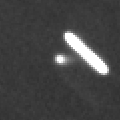
|
Now it is 16.2 mag (Dec. 22, ATLAS-HKO, Haleakala). It stays 16 mag for a while. In the Northern Hemisphere, it stays observable in good condition. In the Southern Hemisphere, it will be unobservable in February.
Date(TT) R.A. (2000) Decl. Delta r Elong. m1 Best Time(A, h)
Dec. 28 12 22.73 36 24.9 4.225 4.572 104 16.0 3:00 (215, 8)
Jan. 4 12 24.98 38 27.3 4.118 4.554 110 15.9 3:06 (208, 9)
|

|
Now it is 16.2 mag (Dec. 14, Ken-ichi Kadota). It stays 16 mag for a while. It locates somewhat low in the Northern Hemisphere. In the Southern Hemisphere, it stays observable in good condition.
Date(TT) R.A. (2000) Decl. Delta r Elong. m1 Best Time(A, h)
Dec. 28 12 44.81 -30 9.3 3.681 3.558 75 16.0 3:00 (278, 48)
Jan. 4 12 51.68 -31 7.5 3.592 3.554 79 16.0 3:06 (276, 54)
|

|
First return of a new periodic comet which brightened up to 15 mag in 2010. Now it is 16.3 mag (Dec. 15, ATLAS Chile). It stays 16 mag for a while. In the Northern Hemisphere, it stays observable in good condition. In the Southern Hemisphere, it will be getting lower gradually.
Date(TT) R.A. (2000) Decl. Delta r Elong. m1 Best Time(A, h)
Dec. 28 2 13.35 13 30.3 1.123 1.819 119 16.2 21:03 (156, 38)
Jan. 4 2 16.06 15 13.7 1.150 1.785 113 16.1 21:03 (150, 34)
|

|
Now it is 15.7 mag (Dec. 23, ATLAS-HKO, Haleakala). Fading slowly. It will be fainter than 18 mag in April. In the Northern Hemisphere, it stays observable in good condition. In the Southern Hemisphere, it is not observable now, but it will appear in April.
Date(TT) R.A. (2000) Decl. Delta r Elong. m1 Best Time(A, h)
Dec. 28 8 39.79 75 38.1 1.899 2.592 125 16.2 2:16 (180,-21)
Jan. 4 8 31.48 75 46.1 1.902 2.601 125 16.2 1:40 (180,-21)
|
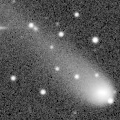
|
Now it is 15.9 mag (Dec. 20, ATLAS Chile). It stays 17 mag for a while. In the Northern Hemisphere, it will be unobservable in April. In the Southern Hemisphere, it stays observable in good condition.
Date(TT) R.A. (2000) Decl. Delta r Elong. m1 Best Time(A, h)
Dec. 28 6 35.12 -51 21.2 6.175 6.504 105 16.2 0:09 ( 0, 74)
Jan. 4 6 24.99 -51 14.4 6.215 6.549 105 16.3 23:26 ( 0, 74)
|
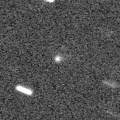
|
Now it is 17.3 mag (Dec. 22, Ken-ichi Kadota). It stays 17 mag for a while. In the Northern Hemisphere, it stays observable in good condition. In the Southern Hemisphere, it will be getting higher gradually.
Date(TT) R.A. (2000) Decl. Delta r Elong. m1 Best Time(A, h)
Dec. 28 14 0.77 -5 0.4 2.353 2.162 66 16.2 3:00 (262, 20)
Jan. 4 14 11.83 -5 37.7 2.308 2.194 71 16.3 3:06 (259, 25)
|
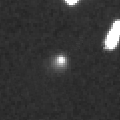
|
Now it is 16.5 mag (Dec. 18, ATLAS South Africa). It stays 16 mag for a while. It locates somewhat low in the Northern Hemisphere. But it will become high in autumn. In the Southern Hemisphere, it stays observable in good condition.
Date(TT) R.A. (2000) Decl. Delta r Elong. m1 Best Time(A, h)
Dec. 28 6 57.64 -30 30.1 6.141 6.763 125 16.2 0:32 (180, 86)
Jan. 4 6 54.78 -30 11.3 6.113 6.752 127 16.2 0:01 (180, 85)
|
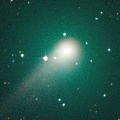
|
It was observed at 9-10 mag for a long time in 2023. Now it is 15.8 mag (Dec. 7, A. Pearce). It stays 17 mag for a while. In the Northern Hemisphere, it will never be observable after this. It locates somewhat low in the Southern Hemisphere. But it will become high in spring.
Date(TT) R.A. (2000) Decl. Delta r Elong. m1 Best Time(A, h)
Dec. 28 21 6.95 -61 49.8 6.969 6.339 47 16.2 21:03 ( 32, 28)
Jan. 4 21 11.32 -61 24.2 7.053 6.394 44 16.3 21:03 ( 31, 25)
|

|
Now it is 16.5 mag (June 6, Giuseppe Pappa). It stays 16 mag for a while. It stays extremely low in the Northern Hemisphere. In the Southern Hemisphere, it stays observable in good condition.
Date(TT) R.A. (2000) Decl. Delta r Elong. m1 Best Time(A, h)
Dec. 28 13 42.28 -43 56.7 5.604 5.198 60 16.4 3:00 (301, 41)
Jan. 4 13 40.13 -44 33.2 5.499 5.196 67 16.4 3:06 (300, 47)
|

|
It brightened up to 14 mag from summer to autumn. Now it is 17.1 mag (Dec. 23, ATLAS Chile). Fading gradually. It will be fainter than 18 mag in February. In the Northern Hemisphere, it stays observable in good condition. In the Southern Hemisphere, it will be getting lower gradually.
Date(TT) R.A. (2000) Decl. Delta r Elong. m1 Best Time(A, h)
Dec. 28 1 52.44 8 35.0 2.177 2.713 112 16.5 21:03 (147, 40)
Jan. 4 1 55.70 9 11.8 2.300 2.747 106 16.7 21:03 (141, 37)
|

|
Parent asteroid of Geminids meteor shower. Now it is 16.0 mag (Nov. 30, Katsumi Yoshimoto). It will brighten rapidly after this. It will be unobservable in March.
Date(TT) R.A. (2000) Decl. Delta r Elong. m1 Best Time(A, h)
Dec. 28 2 0.50 25 24.7 0.925 1.650 119 16.6 21:03 (157, 26)
Jan. 4 1 48.14 22 29.0 0.953 1.579 109 16.7 21:03 (146, 25)
|
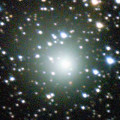
|
It brightened up to 8.3 mag in 2021-2022 winter (Jan. 6, 2022, Toshiyuki Takahashi). Now it is 15.1 mag (Aug. 2, Thomas Lehmann). It stays 17 mag for a while. In the Northern Hemisphere, it will never be observable after this. In the Southern Hemisphere, it stays observable in good condition.
Date(TT) R.A. (2000) Decl. Delta r Elong. m1 Best Time(A, h)
Dec. 28 12 37.97 -55 41.3 9.642 9.344 69 16.6 3:00 (318, 51)
Jan. 4 12 39.18 -56 20.1 9.614 9.388 73 16.6 3:06 (321, 56)
|

|
Now it is 16.4 mag (Dec. 14, ATLAS-HKO, Haleakala). It stays 16 mag for a while. In the Northern Hemisphere, it will be getting lower gradually after this, and it will be unobservable in February. But it will be observable again in March. In the Southern Hemisphere, it is not observable now, but it will appear in April.
Date(TT) R.A. (2000) Decl. Delta r Elong. m1 Best Time(A, h)
Dec. 28 22 10.40 18 20.3 5.728 5.444 68 16.6 21:03 (111, -3)
Jan. 4 22 10.88 17 53.4 5.791 5.401 62 16.6 21:03 (106, -8)
|

|
Now it is 16.7 mag (Dec. 20, ATLAS Chile). Fading slowly. It will be fainter than 18 mag in March. It locates somewhat low in the Northern Hemisphere. In the Southern Hemisphere, it stays observable in good condition.
Date(TT) R.A. (2000) Decl. Delta r Elong. m1 Best Time(A, h)
Dec. 28 8 25.03 -43 27.7 3.562 3.978 108 16.8 1:59 ( 0, 81)
Jan. 4 8 8.83 -43 31.7 3.557 4.027 111 16.8 1:16 ( 0, 81)
|

|
Now it is 16.6 mag (Dec. 22, ATLAS-MLO, Mauna Loa). It will fade out rapidly after this. It will be fainter than 18 mag in February. In the Northern Hemisphere, it stays observable in good condition.
Date(TT) R.A. (2000) Decl. Delta r Elong. m1 Best Time(A, h)
Dec. 28 1 2.76 7 37.4 0.961 1.500 100 16.8 21:03 (134, 35)
Jan. 4 1 24.38 8 14.6 1.026 1.529 99 16.9 21:03 (133, 33)
|

|
Now it is 16.6 mag (Dec. 7, A. Pearce). It stays 17 mag for a while. In the Northern Hemisphere, it stays observable in good condition. In the Southern Hemisphere, it will be getting lower gradually.
Date(TT) R.A. (2000) Decl. Delta r Elong. m1 Best Time(A, h)
Dec. 28 2 39.73 8 44.4 3.268 3.899 123 16.9 21:03 (162, 44)
Jan. 4 2 40.07 8 39.5 3.359 3.900 116 16.9 21:03 (153, 42)
|
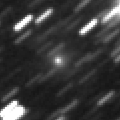
|
Very far object. Now it is 16.9 mag (Dec. 20, ATLAS Chile). It stays 17 mag for a while. In the Northern Hemisphere, it is not observable now. In the Southern Hemisphere, it stays observable in good condition.
Date(TT) R.A. (2000) Decl. Delta r Elong. m1 Best Time(A, h)
Dec. 28 0 47.25 -63 47.9 10.815 10.541 71 16.9 21:03 ( 28, 52)
Jan. 4 0 45.83 -62 57.8 10.872 10.549 68 16.9 21:03 ( 32, 49)
|
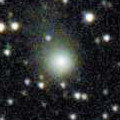
|
It brightened up to 12.1 mag in 2023 spring (May 20, 2023, Jose Guilherme de S. Aguiar). Now it is 16.6 mag (Dec. 21, ATLAS Chile). It stays 17 mag for a while. It locates somewhat low in the Northern Hemisphere. In the Southern Hemisphere, it stays observable in good condition.
Date(TT) R.A. (2000) Decl. Delta r Elong. m1 Best Time(A, h)
Dec. 28 6 6.74 -40 12.9 5.705 6.204 116 16.9 23:36 ( 0, 85)
Jan. 4 6 0.65 -39 29.8 5.755 6.253 116 17.0 23:03 ( 0, 86)
|

|
Now it is 16.9 mag (Sept. 25, ATLAS South Africa). Brightening slowly. It locates somewhat low in the Northern Hemisphere. But it will become high in spring. In the Southern Hemisphere, it will be getting higher gradually.
Date(TT) R.A. (2000) Decl. Delta r Elong. m1 Best Time(A, h)
Dec. 28 15 19.46 -29 56.9 4.163 3.500 42 17.0 3:00 (295, 18)
Jan. 4 15 19.16 -30 11.5 4.049 3.487 49 17.0 3:06 (291, 24)
|
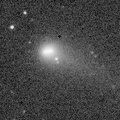
|
It brightened up to 13.5 mag in last winter (Dec. 5, 2023, Chris Wyatt). Now it is 16.6 mag (Nov. 10, J. Nicolas, F. Kugel). It stays 17 mag for a while. In the Northern Hemisphere, it stays observable in good condition. In the Southern Hemisphere, it will be getting higher gradually.
Date(TT) R.A. (2000) Decl. Delta r Elong. m1 Best Time(A, h)
Dec. 28 13 59.38 -5 29.4 3.165 2.921 66 17.0 3:00 (262, 21)
Jan. 4 14 6.28 -6 5.6 3.109 2.959 72 17.1 3:06 (258, 27)
|

|
It will brighten up to 14 mag in 2025 spring. Now it is 16.8 mag (Dec. 24, Ken-ichi Kadota). It will brighten rapidly after this. In the Northern Hemisphere, it stays observable in good condition. In the Southern Hemisphere, it will be getting lower gradually.
Date(TT) R.A. (2000) Decl. Delta r Elong. m1 Best Time(A, h)
Dec. 28 0 10.04 -20 40.9 1.737 1.811 78 17.3 21:03 ( 95, 44)
Jan. 4 0 20.43 -18 43.3 1.759 1.769 74 17.1 21:03 ( 94, 39)
|

|
Now it is 17.1 mag (Dec. 19, ATLAS Chile). It stays 18 mag for a while. It stays observable in good condition.
Date(TT) R.A. (2000) Decl. Delta r Elong. m1 Best Time(A, h)
Dec. 28 3 48.43 -16 33.9 3.334 3.972 124 17.2 21:19 (180, 71)
Jan. 4 3 46.80 -16 9.7 3.401 3.972 119 17.2 21:03 (171, 71)
|

|
It brightened up to 12.0 mag in June (June 13, Ken-ichi Kadota). Now it is 18.0 mag (Dec. 8, Toshihiko Ikemura, Hirohisa Sato). Fading gradually. It will be fainter than 18 mag in February. In the Northern Hemisphere, it stays observable in good condition. It locates somewhat low in the Southern Hemisphere.
Date(TT) R.A. (2000) Decl. Delta r Elong. m1 Best Time(A, h)
Dec. 28 9 37.39 32 45.4 1.764 2.576 137 17.2 3:00 (183, 22)
Jan. 4 9 31.12 33 2.3 1.759 2.626 145 17.3 2:38 (180, 22)
|

|
First return of a new periodic comet which brightened up to 15 mag in 2010. Now it is 17.6 mag (Dec. 8, Toshihiko Ikemura, Hirohisa Sato). Fading gradually. It will be fainter than 18 mag in February. In the Northern Hemisphere, it stays observable in good condition. It locates somewhat low in the Southern Hemisphere.
Date(TT) R.A. (2000) Decl. Delta r Elong. m1 Best Time(A, h)
Dec. 28 9 44.29 30 42.2 1.618 2.423 135 17.4 3:00 (184, 24)
Jan. 4 9 40.52 31 10.4 1.610 2.469 143 17.4 2:47 (180, 24)
|

|
Peculiar asteroid moving along a cometary orbit. Now it is 18.5 mag (Sept. 11, ATLAS-HKO, Haleakala). It stays 17 mag for a while. It stays observable in good condition.
Date(TT) R.A. (2000) Decl. Delta r Elong. m1 Best Time(A, h)
Dec. 28 3 21.86 -15 49.5 1.911 2.549 120 17.4 21:03 (173, 71)
Jan. 4 3 20.25 -15 36.3 1.933 2.502 114 17.5 21:03 (153, 69)
|
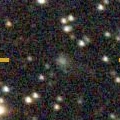
|
Now it is 17.5 mag (Dec. 5, Toshihiko Ikemura, Hirohisa Sato). It stays 18 mag for a while. In the Northern Hemisphere, it stays observable in good condition. It stays extremely low in the Southern Hemisphere.
Date(TT) R.A. (2000) Decl. Delta r Elong. m1 Best Time(A, h)
Dec. 28 7 33.00 41 48.2 6.169 7.085 157 17.5 1:08 (180, 13)
Jan. 4 7 30.05 41 54.3 6.169 7.100 159 17.5 0:37 (180, 13)
|
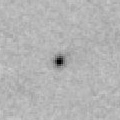
|
Now it is 17.0 mag (Dec. 23, ATLAS Chile). It stays 18 mag for a while. It stays observable in good condition.
Date(TT) R.A. (2000) Decl. Delta r Elong. m1 Best Time(A, h)
Dec. 28 6 44.65 -7 57.2 3.684 4.551 148 17.7 0:19 (180, 63)
Jan. 4 6 40.37 -8 22.2 3.677 4.545 148 17.6 23:43 (180, 63)
|

|
Now it is 17.9 mag (May 17, J. L. Virlichie, P. Traverse, H. Roy). It stays 17 mag for a while. It stays extremely low in the Northern Hemisphere. But it will become high in autumn. In the Southern Hemisphere, it stays observable in good condition.
Date(TT) R.A. (2000) Decl. Delta r Elong. m1 Best Time(A, h)
Dec. 28 13 1.20 -48 7.4 5.791 5.490 67 17.7 3:00 (306, 49)
Jan. 4 13 0.46 -48 18.9 5.686 5.478 72 17.7 3:06 (306, 54)
|
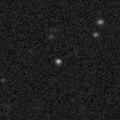
|
Now it is 18.0 mag (Aug. 18, Taras Prystavski). It stays 18 mag for a while. In the Northern Hemisphere, it stays observable in good condition. It locates somewhat low in the Southern Hemisphere.
Date(TT) R.A. (2000) Decl. Delta r Elong. m1 Best Time(A, h)
Dec. 28 7 24.60 37 34.7 7.874 8.810 161 17.7 1:00 (180, 17)
Jan. 4 7 18.74 37 26.5 7.863 8.815 164 17.7 0:26 (180, 18)
|

|
Now it is 18.3 mag (Dec. 12, Ken-ichi Kadota). Fading slowly. It will be fainter than 18 mag in January. In the Northern Hemisphere, it stays observable in good condition. It locates somewhat low in the Southern Hemisphere.
Date(TT) R.A. (2000) Decl. Delta r Elong. m1 Best Time(A, h)
Dec. 28 10 12.35 32 29.7 1.983 2.722 130 17.8 3:00 (191, 22)
Jan. 4 10 8.76 32 52.0 1.956 2.759 137 17.9 3:06 (182, 22)
|
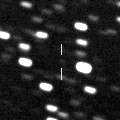
|
Now it is 17.3 mag (Dec. 20, ATLAS Chile). It stays 18 mag for a while. In the Northern Hemisphere, it will never be observable after this. In the Southern Hemisphere, it stays observable in good condition.
Date(TT) R.A. (2000) Decl. Delta r Elong. m1 Best Time(A, h)
Dec. 28 4 9.21 -60 20.5 4.880 5.007 91 17.9 21:38 ( 0, 65)
Jan. 4 3 54.17 -59 54.8 4.931 5.014 89 18.0 21:03 ( 2, 65)
|

|
Now it is 17.3 mag (Dec. 6, ATLAS-MLO, Mauna Loa). Fading gradually. It will be fainter than 18 mag in January. In the Northern Hemisphere, it stays observable in good condition. In the Southern Hemisphere, it will be getting lower gradually.
Date(TT) R.A. (2000) Decl. Delta r Elong. m1 Best Time(A, h)
Dec. 28 1 12.19 1 7.4 1.676 2.094 100 17.9 21:03 (131, 41)
Jan. 4 1 21.09 2 15.6 1.764 2.108 96 18.1 21:03 (127, 37)
|
|
![]()
 C/2022 QE78 ( ATLAS )
C/2022 QE78 ( ATLAS ) 37P/Forbes
37P/Forbes C/2021 G2 ( ATLAS )
C/2021 G2 ( ATLAS ) C/2022 N2 ( PanSTARRS )
C/2022 N2 ( PanSTARRS ) C/2024 J2 ( Wierzchos )
C/2024 J2 ( Wierzchos ) P/2023 S1
P/2023 S1 249P/LINEAR
249P/LINEAR C/2024 M1 ( ATLAS )
C/2024 M1 ( ATLAS ) C/2024 B1 ( Lemmon )
C/2024 B1 ( Lemmon ) C/2024 Y1 ( Masek )
C/2024 Y1 ( Masek ) C/2014 UN271 ( Bernardinelli-Bernstein )
C/2014 UN271 ( Bernardinelli-Bernstein ) 48P/Johnson
48P/Johnson 472P/2023 RL75 ( NEAT-LINEAR )
472P/2023 RL75 ( NEAT-LINEAR ) C/2021 S3 ( PanSTARRS )
C/2021 S3 ( PanSTARRS ) 43P/Wolf-Harrington
43P/Wolf-Harrington C/2017 K2 ( PanSTARRS )
C/2017 K2 ( PanSTARRS ) C/2024 A1 ( ATLAS )
C/2024 A1 ( ATLAS ) 487P/2024 N5 ( Siding Spring )
487P/2024 N5 ( Siding Spring ) C/2023 H5 ( Lemmon )
C/2023 H5 ( Lemmon ) C/2023 T3 ( Fuls )
C/2023 T3 ( Fuls ) 496P/2024 S3 ( Hill )
496P/2024 S3 ( Hill ) C/2023 Q1 ( PanSTARRS )
C/2023 Q1 ( PanSTARRS ) C/2019 U5 ( PanSTARRS )
C/2019 U5 ( PanSTARRS ) 30P/Reinmuth 1
30P/Reinmuth 1 C/2022 R6 ( PanSTARRS )
C/2022 R6 ( PanSTARRS ) C/2020 V2 ( ZTF )
C/2020 V2 ( ZTF ) C/2023 F3 ( ATLAS )
C/2023 F3 ( ATLAS ) 130P/McNaught-Hughes
130P/McNaught-Hughes (3200) Phaethon
(3200) Phaethon C/2019 L3 ( ATLAS )
C/2019 L3 ( ATLAS ) C/2023 R1 ( PanSTARRS )
C/2023 R1 ( PanSTARRS ) C/2022 L2 ( ATLAS )
C/2022 L2 ( ATLAS ) 305P/Skiff
305P/Skiff 276P/Vorobjov
276P/Vorobjov C/2019 E3 ( ATLAS )
C/2019 E3 ( ATLAS ) C/2020 K1 ( PanSTARRS )
C/2020 K1 ( PanSTARRS ) C/2024 L5 ( ATLAS )
C/2024 L5 ( ATLAS ) 32P/Comas Sola
32P/Comas Sola 49P/Arend-Rigaux
49P/Arend-Rigaux 242P/Spahr
242P/Spahr 154P/Brewington
154P/Brewington 492P/2024 O3 ( LINEAR )
492P/2024 O3 ( LINEAR ) (308607) 2005 WY3
(308607) 2005 WY3 C/2021 S4 ( Tsuchinshan )
C/2021 S4 ( Tsuchinshan ) 195P/Hill
195P/Hill C/2024 G2 ( ATLAS )
C/2024 G2 ( ATLAS ) (468861) 2013 LU28
(468861) 2013 LU28 50P/Arend
50P/Arend C/2023 U1 ( Fuls )
C/2023 U1 ( Fuls ) 253P/PanSTARRS
253P/PanSTARRS![]()






















































